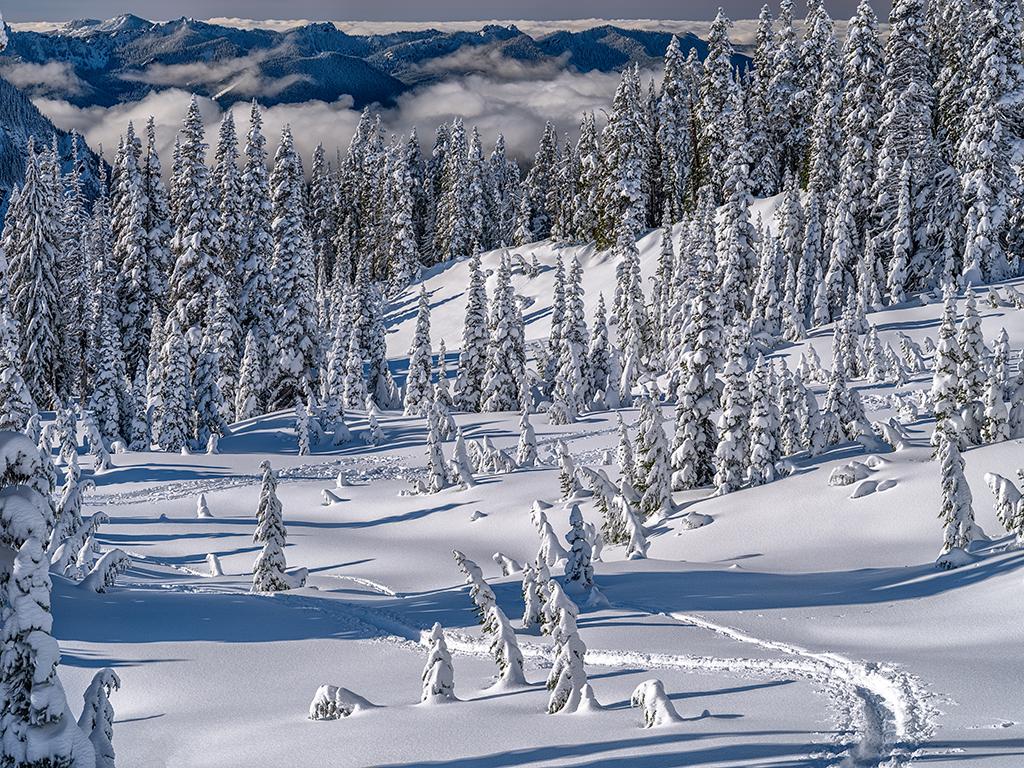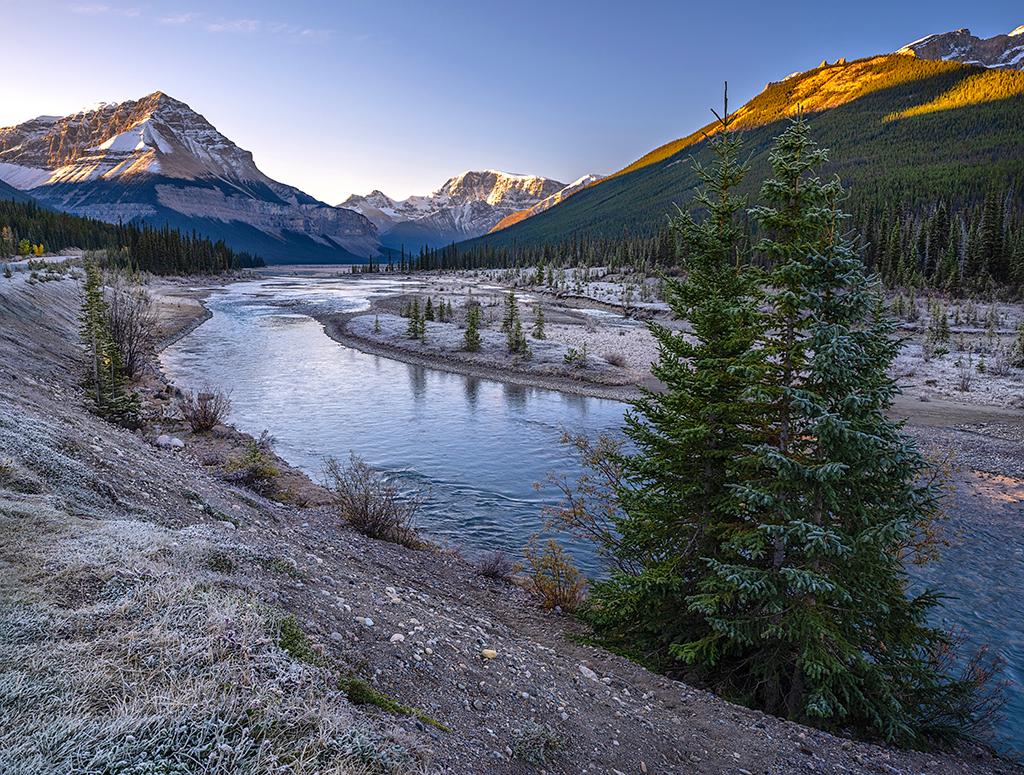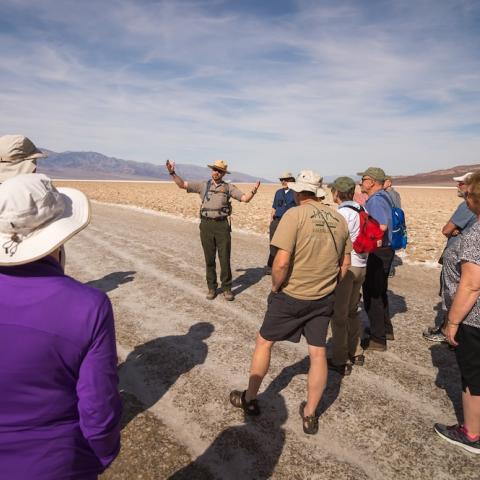
The Demonstration Garden, Fort Vancouver National Historic Site / Rebecca Latson
Happy New Year! Yay, the National Parks Traveler is still here – for now, at least - and it’s thanks to you readers and listeners who have donated.
In keeping with a tradition started several years ago, this first photo column of the new year is a collection of my 10 favorite images captured during 2023. Last year, I traveled to Mount Rainier and Death Valley national parks, Fort Vancouver National Historic Site, and four national parks in the Canadian Rockies (Kootenay, Yoho, Banff, Jasper). As usual, it was difficult to choose just 10 photos, but here they are, in no specific order, along with why I like them so much and how I got the shot.
The Fort Vancouver Garden, Fort Vancouver National Historic Site (Washington)
I know, right? This is such a cliché shot as the fort garden is probably one of the most-photographed spots at this national historic site. Previous research directed me to plan my visit during the height of the garden season, which is midsummer. The flowers are in full bloom, the vegetables are ripe or almost ripe, and the colors are saturated. I also like the leading line (one of my favorite photo themes) of this walkway through the garden. Of course, the crowds can get heavy because the fort garden is really one of the prettiest parts of this very interesting historic site.
I left the tripod in the car that day and simply walked around with my cameras and pack, so this shot is handheld. I used the “burst mode” of capturing this image, pressing the shutter button for several clicks. Out of one of those multiple images, I knew I’d (probably) get a clear, sharp shot. It takes up memory space, but it works.
Winter Landscape At Paradise, Mount Rainier National Park (Washington)

Winter landscape at Paradise, Mount Rainier National Park / Rebecca Latson
“The Mountain” is nowhere in sight in this image. Instead, I turned the camera toward the snowy scene along the trail. I visited the Paradise area of the park on New Year’s Day and couldn’t believe my good luck at the clear skies, bright sun, and fluffy, sparkly snow. The Tatoosh Mountains are in the distance and the foreground shows snow-flocked trees with leading lines of snowshoe, cross-country ski, and animal trails. This image was also captured without a tripod since I utilized two hiking poles instead of my usual tripod-as-hiking-stick modus operandi to keep me balanced on the uneven surface.
Car Lights, Hiker Lights, And Meteor Lights, Sunrise Area, Mount Rainier National Park (Washington)

Car lights, hiker lights, and meteor light, Mount Rainier National Park / Rebecca Latson
Photography is probably 98 percent pure luck, and this was a heck of a lucky shot. Out of 300 timed-interval images captured by the camera for creating a timelapse during one of the days of peak Perseid meteor shower activity, I managed to capture this bright meteor streak.
Venturing from my vehicle around 4 a.m., I set up camera and tripod for timelapse shots filled with light pinpoints of climbers on Mount Rainier, the steady line of car headlights in the parking area, and hiker lights along the trails. At one point, a large, brilliant meteor trail streaked downward. While exclaiming my delight, I fervently hoped the camera picked up that momentary shot of bright light. Upon returning home and perusing the photos, I realized the camera had, indeed, captured a single image including this one bright line of light.
For night photography and timed-interval imagery, a tripod is an absolute requirement when using a slow shutter speed and wide aperture. A corded or wireless shutter release is also helpful, because your finger is not touching that shutter button and creating slight vibration to the resulting image.
The Leading Line Of Road Across Panamint Valley, Death Valley National Park (California)

The leading line of road across Panamint Valley, Death Valley National Park / Rebecca Latson
After an early-morning landscape session at Father Crowley Vista Point on the far western side of the park, I headed back toward Furnace Creek. As I descended the hill into Panamint Valley, I noticed the leading line of road and pulled over onto the soft, sandy shoulder. Waiting until no cars headed my way, I stood smack dab in the center of the road to frame this composition.
I’d photographed both horizontal and vertical images, and decided the vertical looked the most striking, since it emphasized that ribbon of road running upward into the hills and beyond.
September Layers, Jasper National Park (Alberta, Canada)

September layers, Jasper National Park / Rebecca Latson
September is a grab bag of weather in the Canadian Rockies. Some days produce crystal clear, bluebird skies while other days, like this one, hide those rugged mountains behind layers of moody, swiftly-moving autumn rainclouds. I stood on one side of the Athabasca River, looking across toward those layers on the other side. Using my telephoto lens, I zoomed in for a closer look at the part of the mountain revealed between those shifting clouds. Telephoto lenses make for great landscapes, you know.
A Frosty Morning Along The Athabasca River, Jasper National Park (Alberta, Canada)

A frosty morning along the Athabasca River, Jasper National Park / Rebecca Latson
The day of my return drive to Washington state dawned sharply clear and freezing (28 degrees Fahrenheit). Along the Icefields Parkway, maybe a mile or two north of the HI Beauty Creek Wilderness Hostel, is a large pullout with a view of the Athabasca River and rugged mountains on either side. I knew my trip home was going to take a little longer (ok, maybe a couple of hours longer) because of my constant photo stops, but I couldn’t help myself. Landscapes hidden by the rainy weather on my way to Jasper Townsite were revealed to me that morning.
Sunset At Dantes View, Death Valley National Park (California)

Sunset at Dantes View, Death Valley National Park / Rebecca Latson
The two most popular view areas in this park are Dantes View and Zabriskie Point, both of which look out toward the west. This means you won’t see the actual sun rise unless you face in the opposite direction. Sunset, on the other hand, displays that brilliant globe of orange-yellow light sinking below the Panamint Mountains.
I have to say Dantes View was my favorite area for sunset photography. I can see so many things: the long, white line of a trail leading from the Badwater Basin parking lot to the wide salt flat where I stood earlier that day; the flat, five-to-fifteen-mile (eight-to-twenty-four-kilometer) expanse of valley from the Amargosa Range on which I stood looking out toward the Panamint Range on the other side; a portion of the 140-mile (225-kilometer) length of the valley; and the setting sun, itself. I also liked the golden light bathing the vegetation and slope just below me and my tripod – a sort of “last hurrah” before the sun’s complete departure for the day.
The Beginning Of Night, Just After Sunset At The Sunrise Area of Mount Rainier National Park (Washington)

After sunset and the beginning of nighttime, Mount Rainier National Park / Rebecca Latson
I’m a sunrise sort of gal, so it takes something special – like the Perseid meteor shower – to keep me out past sunset. I knew this would be a popular night with lots of people, so I remained in one spot with tripod and camera to capture at least a few stars on one side of the mountain while the horizon remained bright on the other side. Luckily, the Milky Way appeared at the same time as this interesting cloud moving toward Mount Rainier’s summit. In retrospect, this is a busy image, with “The Mountain” as the focal point around which everything else revolves.
Steps To A View Of Spirit Island And Maligne Lake, Jasper National Park (Alberta, Canada)

Steps to a view of the "beating heart" and "living lake", Jasper National Park / Rebecca Latson
Yeah, my favorite Canada images are basically all within Jasper National Park. Of the four beautiful Canadian Rockies parks visited, Jasper captured my attention the most, although there are a few from those other three parks that I would have chosen had I not limited my favorites to 10 images. And the highlight of my visit was a boat tour around Maligne Lake with a 30-minute stop to view and photograph Spirit Island, which is not an island at all, but a small land area on the lake connected by an isthmus to the larger landscape upon which I and my fellow boat passengers stood.
So, why on earth would l want to include a set of wooden stairs in this landscape image? Not only did I liked the leading-line perspective my wide-angle lens produced as I stood near the top of the steps looking down and beyond toward the “island,” but I liked that perspective as opposed to an eye-level shot. The natural frame created by the trees on either side of the composition provided a nice extra to the shot
Take note of that one tree framing the right side of the image. Do you see an eye and a nostril? The eye appears to be watching and perhaps judging the viewer’s worthiness to see this sacred landscape revered by the Stoney-Nakoda First Nation, who believe everything has a spirit, and Spirit Island is the heart of the living lake.
The Immensity Of It All, Zabriskie Point, Death Valley National Park (California)

The immensity of it all at Zabriskie Point, Death Valley National Park / Rebecca Latson
This was my last sunset in Death Valley before heading back to Las Vegas the next morning. I’d been there for sunset a few days previously and knew what I could expect in terms of light. So, I almost didn’t even go, I was so tired from the excursions spent on this last day in addition to the draining heat (actually, it was probably only 110 degrees Fahrenheit that day). At the very last minute, I decided what the heck and hopped in the truck for a return trip to Zabriskie Point.
Hefting camera and tripod up the curving paved walkway, I noticed this large thunderhead hovering over the Panamint Mountains across the valley. Time passed and the cloud continued expanding. Wisps of rain fell from beneath the cloud’s flat bottom, obscuring a portion of the setting sun, while the sunlight created a rim of backlighting around the cloud. And then, this one man stepped into the composition. Was I annoyed? No! I could have removed him from the resulting image (actually, I have a copy without him), but to be honest, the visual appeal of that one man against the expanding immensity of that “thunderbumper” looming over the valley created a grand sense of scale the viewer would understand.
And I almost didn’t even go there that evening! See what I would have missed!
Ok, so there you have it: my 10 favorite images from all those captured over the course of 2023. I’m not certain where my cameras will take me this 2024, but whatever unit of the National Park System I visit, you can be sure I’ll be writing about it for the Traveler.




 Support Essential Coverage of Essential Places
Support Essential Coverage of Essential Places






